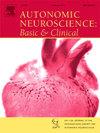Monotherapy with tolterodine or mirabegron is insufficient for ameliorating cyclophosphamide-induced bladder overactivity in rats
IF 3.2
4区 医学
Q2 NEUROSCIENCES
引用次数: 0
Abstract
Monotherapy continues to be the most common pharmacological treatment option for patients with overactive bladder (OAB), despite evidence indicating that it may have inferior efficacy compared to combination therapy. This seems to be especially true for patients with concomitant cystitis. The current study examined the effects of monotherapy with either the antimuscarinic tolterodine or the β3 agonist mirabegron on bladder overactivity induced by bladder inflammation. Further, the possible involvement of nitric oxide (NO) was studied. For this purpose, rats were pretreated with either drug for 10 days. Bladder inflammation was induced by intraperitoneal injection with cyclophosphamide, with saline serving as control. Micturition parameters were assessed in a metabolic cage. Meanwhile, urine samples were collected and further analysed for NO content. After 16 h, the animals were euthanized, and their bladders were excised and examined immunohistochemically for signs of inflammation. Cyclophosphamide treatment led to bladder overactivity and obvious signs of inflammation. Neither treatment with tolterodine nor mirabegron could significantly alleviate the induced overactivity or the observed inflammation. Further, while induction of inflammation led to a significant increase in NO production, neither drug seemed to act by further enhancing its production. On the contrary, treatment with either tolterodine or mirabegron significantly decreased NO production in cyclophosphamide treated rats. Considering previous findings showing significant improvement by combination therapy, the current study indirectly implies this as the superior treatment option. Further studies are needed to verify the involvement, or lack thereof, of NO in the mechanism of action of drugs used to treat OAB.
托特罗定或mirabegron单药治疗不足以改善大鼠环磷酰胺诱导的膀胱过度活动
单药治疗仍然是膀胱过动症(OAB)患者最常见的药物治疗选择,尽管有证据表明,与联合治疗相比,单药治疗的疗效可能较差。对于伴有膀胱炎的患者尤其如此。目前的研究考察了抗毒蕈碱托特罗定或β3激动剂mirabegron单药治疗膀胱炎症引起的膀胱过度活动的效果。进一步研究了一氧化氮(NO)的可能参与。为此,大鼠分别用两种药物预处理10天。腹腔注射环磷酰胺诱导膀胱炎症,生理盐水作为对照组。在代谢笼中评估排尿参数。同时,收集尿液样本并进一步分析NO含量。16小时后,对动物实施安乐死,切除膀胱,免疫组织化学检查炎症迹象。环磷酰胺治疗导致膀胱过度活动和明显的炎症迹象。托特罗定和米拉贝隆治疗均不能明显减轻诱导的过度活动或观察到的炎症。此外,虽然炎症诱导导致NO的产生显著增加,但两种药物似乎都没有通过进一步提高其产生来起作用。相反,托特罗定或mirabegron均可显著降低环磷酰胺处理大鼠的NO生成。考虑到先前的研究结果显示联合治疗有显著改善,当前的研究间接表明联合治疗是更好的治疗选择。需要进一步的研究来证实一氧化氮是否参与治疗OAB的药物的作用机制。
本文章由计算机程序翻译,如有差异,请以英文原文为准。
求助全文
约1分钟内获得全文
求助全文
来源期刊
CiteScore
5.80
自引率
7.40%
发文量
83
审稿时长
66 days
期刊介绍:
This is an international journal with broad coverage of all aspects of the autonomic nervous system in man and animals. The main areas of interest include the innervation of blood vessels and viscera, autonomic ganglia, efferent and afferent autonomic pathways, and autonomic nuclei and pathways in the central nervous system.
The Editors will consider papers that deal with any aspect of the autonomic nervous system, including structure, physiology, pharmacology, biochemistry, development, evolution, ageing, behavioural aspects, integrative role and influence on emotional and physical states of the body. Interdisciplinary studies will be encouraged. Studies dealing with human pathology will be also welcome.

 求助内容:
求助内容: 应助结果提醒方式:
应助结果提醒方式:


